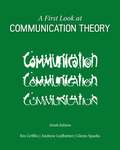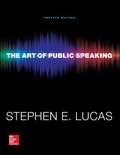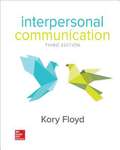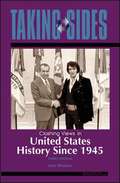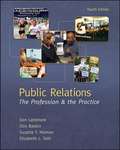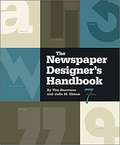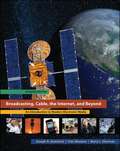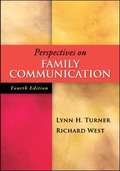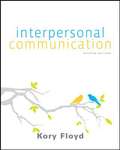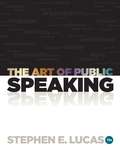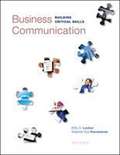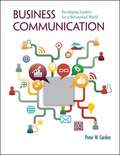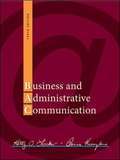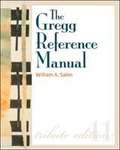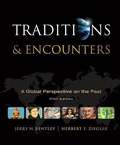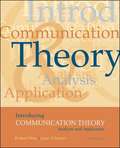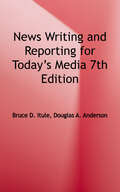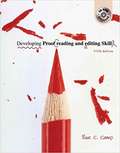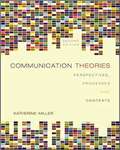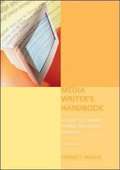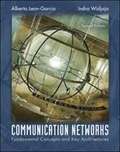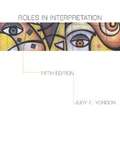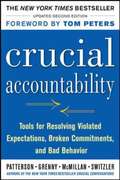- Table View
- List View
A First Look at Communication Theory (Ninth Edition)
by Em Griffin Andrew Ledbetter Glenn SparksThe ninth edition of A First Look at Communication Theory justifies again the program's enduring popularity. Em Griffin, now joined by colleagues Andrew Ledbetter and Glenn Sparks, encourages students who are encountering the field for the first time to tackle theories without fear. The authors introduce 32 diverse theories that are a mix of foundational and recent scholarship and, with the benefit of numerous examples and connections to pop culture, help students apply them to their own lives. This program ensures that students have a solid foundation with which to begin understanding the relationships between theories.
The Art of Public Speaking 12th Edition
by Stephen LucasThe Art of Public Speaking personalizes learning for every student no matter who they are or where they are, ensuring that they come to your public speaking class confident, prepared with the principle foundations, and ready to participate in your teaching and coaching. Connect is the only integrated learning system that empowers students by continuously adapting to deliver precisely what they need, when they need it, and how they need it, so that your class time is more engaging and effective.
Interpersonal Communication
by Kory FloydKory Floyd McGraw-Hill Education, 22 May 2012 - Language Arts & Disciplines - 480 pages 0 Reviews Kory Floyd's approach to interpersonal communication stems from his research on the positive impact of communication on our health and well-being. Interpersonal Communication, 2e demonstrates how effective interpersonal communication can make students' lives better. With careful consideration given to the impact of computer-mediated communication, the program reflects the rapid changes of the modern world in which today’s students live and interact. The program also helps students understand and build interpersonal skills and choices for their academic, personal, and professional lives.
Taking Sides: Clashing Views In United States History Since 1945
by Larry MadarasThis Third Edition of TAKING SIDES: UNITED STATES HISTORY SINCE 1945 presents current controversial issues in a debate-style format designed to stimulate student interest and develop critical thinking skills. Each issue is thoughtfully framed with an issue summary, an issue introduction, and a postscript. An instructor's manual with testing material is available for each volume.
Public Relations: The Profession and the Practice, 4th Edition
by Dan Lattimore Otis Baskin Suzette T. Heiman Elizabeth L. TothThis edition retains the four-part organization of earlier editions: the profession, the process, the publics, and the practice. Part 1 describes the current public relations situation, its historical roots, theories, and ethical and legal concerns. Part 2 examines the core issues of the process that underlie public relations. Part 3 focuses on the publics that are the object of these efforts. Part 4 summarizes the practice of public relations and looks at the emerging trends of the profession.
The Newspaper Designer's Handbook
by Tim Harrower Julie ElmanThroughout the seven editions of this book, Harrower has successfully deconstructed the process of laying out newspaper pages. For journalism students and professionals alike, countless designers have used this book to learn how to design and improve their skills as visual communicators. Harrower’s unique voice and quirky sense of humor are still very much alive in the seventh edition.
Broadcasting, Cable, The Internet, And Beyond: An Introduction To Modern Electronic Media
by Joseph R. Dominick Barry L. Sherman Fritz J. MessereThis survey of the field of modern electronic media includes the new technologies, regulations, programming, and competition that affect our world and the broadcasting industry. The text conveys the excitement of the industry in a highly accessible style that makes even the most difficult information understandable.
Perspectives on Family Communication
by Richard West Lynn H. TurnerEmphasizing the role that communication plays in both creating and solving family issues, Perspectives on Family Communication thoroughly reflects the explosion of research literature in the area of family communication. Now in its fourth successful edition, the text continues to emphasize the role that communication plays in the evolution of family issues. Throughout, the text examines a wide variety of contemporary family types and supports this examination with current research and practical examples.
Interpersonal Communication (Second Edition)
by Kory FloydKory Floyd's approach to interpersonal communication stems from his research on the positive impact of communication on our health and well-being. Interpersonal Communication, 2e demonstrates how effective interpersonal communication can make students' lives better. With careful consideration given to the impact of computer-mediated communication, the program reflects the rapid changes of the modern world in which today's students live and interact. The program also helps students understand and build interpersonal skills and choices for their academic, personal, and professional lives.
The Art of Public Speaking
by Stephen LucasThe Art of Public Speaking 11e continues to define the art of being the best by helping today's students become capable, responsible speakers and thinkers. With a strong focus on the practical skills of public speaking and grounded in classical and contemporary theories of rhetoric, The Art of Public Speaking offers full coverage of all major aspects of speech preparation and presentation. Utilizing the full suite of resources, students learn to internalize the principles of public speaking, build confidence through speech practice, and prepare for success in the classroom and beyond. With the new Enhanced Speech Capture in Connect Lucas, instructors now have the ability to evaluate live speeches using a customizable rubric in the classroom. Instructors may also upload speech videos on students' behalf to create and manage true peer review assignments. With its ground-breaking adaptive learning system, Connect LucasTM also helps students "know what they know," while guiding them to experience and learn important concepts that they need to know to succeed. With McGraw-Hill CreateTM, instructors can now customize their Lucas 11e textbook to the section level, selecting and arranging only the sections covered in the course. The new Create system will automatically repaginate and re-number chapters, sections, graphs, and illustrations, based on how the instructor chooses to arrange them. This deep level of customization guarantees that students pay only for the content covered in the course.
Business Communication: Building Critical Skills
by Stephen Kaczmarek Kitty LockerBusiness Communication: Building Critical Skills was built to provide the ultimate in freedom, flexibility, and focused classroom. Broken into 30 modular chapters, this text provides topic-focused modules, allowing instructors to customize their resources piece-by-piece to best suite their course and teaching style. Each module has a strong workplace activity orientation, supporting students to build critical skills in writing, speaking, and listening. Locker/Kaczmarek is grounded in solid business communication fundamentals, and supports students to piece together what is needed to be a successful communicator for the 21st century.
Business Communication: Developing Leaders For A Networked World
by Peter W. CardonThe Business Communication field is at a crossroads as communication technologies are reshaping how people communicate in the workplace. Business Communication: Developing Leaders for a Networked World, by Peter Cardon, puts students at the center of business communication through the author's unique focus on credibility woven throughout the textbook chapters, forward looking vision built on traditional concepts, and practitioner and case-based approach. Students are more likely to read and reflect on the text, and are better positioned to understand the essentials of efficient and effective business communication, thereby transforming them into leaders for a networked world.
Business and Administrative Communication (Tenth Edition)
by Kitty O. Locker Donna KienzlerThe tenth edition of Business and Administrative Communication is a true leader in the business communication field. It is described as flexible, specific, interesting, comprehensive, and up-to-date. Unique among business communications textbooks, it focuses on the rhetorical emphases of audience, purpose, and context to allow communicators to shape their messages more appropriately to all channels and for all purposes. Beyond covering the broad scope of topics in all forms of business communication, this text uses a student-friendly writing style and strong design elements to hold students' attention. Real-world examples and real business applications underscore the relevance and importance of the material to the business communication students' academic and career work. The tenth edition also conveys the best possible advice to students through its research base; the author's reputation as a contributor to this field of study lends an even greater element of “teachability” and relevance to this market-leading title.
The Gregg Reference Manual: A Manual of Style, Grammar, Usage, and Formatting
by William SabinThe Gregg Reference Manual is intended for anyone who writes, edits, or prepares material for distribution or publication. For over fifty years this manual has been recognized as the best style manual for business professionals and for students who want to master the on-the-job standards of business professionals.
Traditions and Encounters: A Global Perspective on the Past (5th Edition)
by Herbert F. Ziegler Jerry H. BentleyConnect students to the stories of history. Connect students to the experience of history. Connect students to success in history. At McGraw-Hill, we have dedicated the past few years to deepening our understanding of student and instructor experience. Employing a wide array of research tools including surveys, focus groups, and ethnographic studies, we've identified areas in need of improvement to provide an opportunity for greater learning and teaching experiences. The fifth edition of Traditions & Encounters is a result of this. Traditions & Encounters also has a rich history of firsts: the first world history text to take a truly global perspective on the past; the first to emphasize connections among cultures; the first to combine twin themes with a seven-part framework, making the huge story of world history more manageable to both teach and learn. Now Traditions & Encounters becomes the first truly interactive world history program: one that marries groundbreaking adaptive diagnostics and interactivities with a captivating narrative and engaging visuals, creating a unique learning environment that propels greater student success and better course results. Instructors gain insight into students' engagement and understanding as students develop a base of knowledge and construct critical thinking skills. Chapter-opening vignettes and a lively narrative keep students turning the page while the adaptive questioning for each chapter and the personalized study plan for each individual student help students prepare for class discussions and course work. With its hallmark of twin themes, Traditions & Encounters continues to tell the story of the cultures and interactions that have shaped world history, while adding redesigned maps, new primary sources, and new chapter- and part-level features that strengthen connections and prompt students to analyze the events and themes in order to build a greater understanding of the past and an appreciation of history's influence on the present. Students are no longer simply reading; they are reading, interacting, and engaging in a visual, auditory, and hands-on learning experience. Give students an experience. Improve course participation and performance. Experience Traditions & Encounters, and experience success.
Human Communication (3rd edition)
by Judy C. Pearson Paul E. Nelson Scott Titsworth Lynn HarterTextbook with 3 main sections: Fundamentals of Communication Studies, Communication Contexts, and Fundamentals of Public Speaking: Preparation and Delivery.
Introducing Communication Theory: Analysis And Application
by Lynn H. Turner Richard WestThis popular text introduces the field of communication to students who may have little or no background in communication theory. Its three overriding goals are to help students understand the pervasiveness of theory in their lives, to demystify the theoretical process, and to help students become more systematic and critical on their thinking about theory. Each theory chapter follows a consistent format that includes a vignette, an introduction, a summary of assumptions, a description of core concepts, and a critique. This consistency provides continuity for students and ensures a balanced presentation of theories. The Third edition includes the most current communication research available (at the time), with over 100 new references.
Student Study Guide for use with Traditions and Encounters, A Global Perspective on the Past, Volume 1, From the Beginning to 1500
by Rose Mary Sheldon Herbert F. Ziegler Jerry H. BentleyNIMAC-sourced textbook
News Writing and Reporting for Today's Media
by Bruce D. Itule Douglas A. AndersonNews Writing and Reporting takes students on the beat, into the press box, council chambers, and courthouse, and to a speech and press conference. It introduces them to current issues such as cultural sensitivity, multimedia journalism, and legal and ethical considerations that journalists face every day. Throughout the text, reporters and editors offer their down-to-earth advice, and, whenever possible, professional journalists covering actual stories are used as instructional models. Students are exposed to the work of professionals while gathering the tools to follow in their footsteps.
Developing Proofreading And Editing Skills
by Sue C. CampDeveloping Proofreading and Editing Skills, 5/e by Camp provides instruction and applications designed to sharpen skills in detecting and correcting errors in written communications including memos, letters, reports, email messages, databases, presentation slides, advertisements, and spreadsheets. The material progresses from easy-to-recognize errors to those more difficult to spot, allowing students to build confidence and skill. Highlights of the 5th edition include a discussion of voice-recognition technology and proofreading and editing, end-of-chapter text applications with two applications in each chapter available on CD-ROM, and a series of seven review modules offering challenging proofreading practice.
Communication Theories: Perspectives, Processes, And Contexts
by Katherine MillerProviding a current and comprehensive discussion of influential theories in communication, this text portrays the strengths and weaknesses of each theory. Communication Theories helps students see where these theories fit in the broad scheme of social inquiry and generally guides students in the evaluation and critique of theories in order to reach a more sophisticated level of understanding. Although it emphasizes theories developed by communication scholars, Communication Theories also includes work developed outside the field that has strongly influenced the work of communication scholars. The second edition has been completely updated to include new or enhanced coverage of post-colonialism, critical race theory, new generation social penetration theory, and mass media reception theory.
Media Writers Handbook
by George T. ArnoldDiscusses common pitfalls in journalistic writing and how to avoid them.
Communication Networks: Fundamental Concepts and Key Architectures (Second Edition)
by Alberto Leon-Garcia Indra WidjajaThis work is designed for introductory one-semester or one-year courses in communications networks in upper-level undergraduate programmes. The Big Picture is presented with a discussion of network-based applications and services such as the WWW, e-mail and home video entertainment. The essential functions in the operation of a network are discussed, and examples are given that motivate the notion of layering, and the OSI Reference model. Exposing students to the big picture should help them learn and apply the information more readily. Network performance is introduced as an integral part of network design and operation.
Roles in Interpretation (Fifth Edition)
by Judy E. YordonInterpretation is an artistic process of studying literature through performance and sharing that study with an audience. Yordon's Roles in Interpretation prepares students for the roles they will play in performances by explaining interpretation through a wide variety of literary forms, performance styles, and recent theories of interpretation.
Crucial Accountability: Tools for Resolving Violated Expectations, Broken Commitments, and Bad Behavior (Second Edition)
by Kerry Patterson Joseph Grenny Ron Mcmillan Al Switzler David Maxfield.In this UPDATED SECOND EDITION (first edition titled "Crucial Confrontations"), you'll learn how to hold anyone accountable, master performance discussions, and get results. Everyone knows how to run for cover, or, if sufficiently provoked, step up to problems in a way that causes a real ruckus. Crucial Accountability teaches you how to deal with violated expectations in a way that solves the problem at hand without harming the relationship--and, in fact, even strengthens it. Broken promises, missed deadlines, poor behavior--they don't just make others' lives miserable; they can sap up to 50 percent of organizational performance and account for the vast majority of divorces. Crucial Accountability offers the tools for improving relationships in the workplace and in life and for resolving all these problems--permanently.
